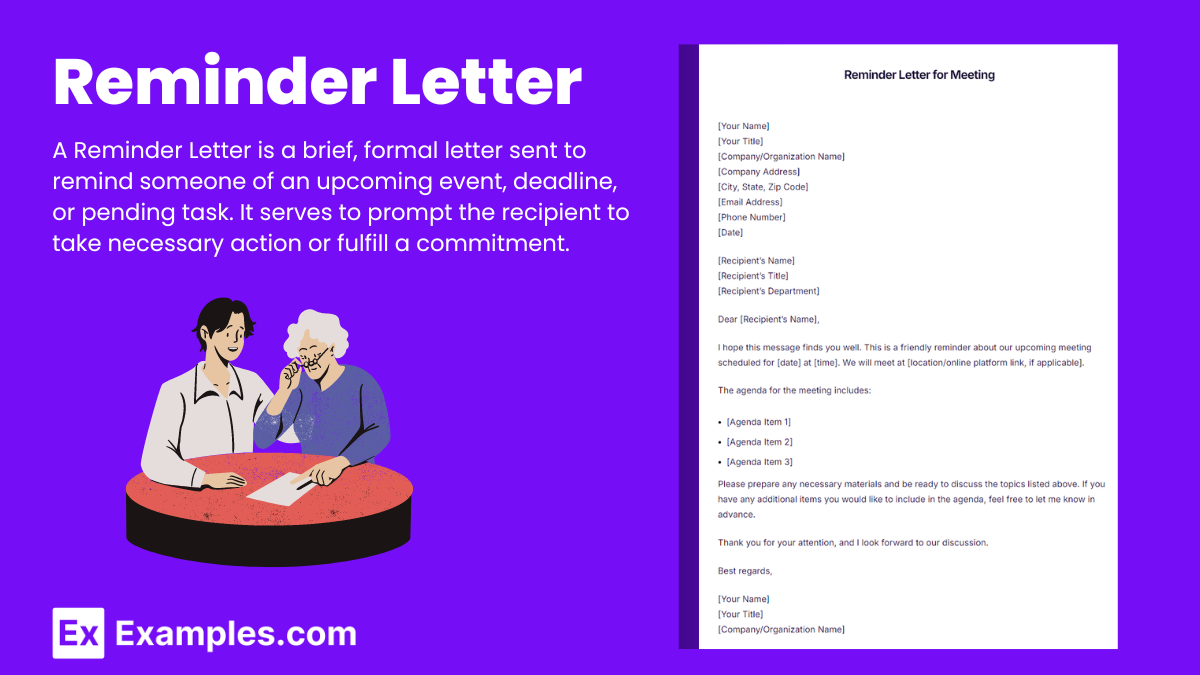12+ Reminder Letter Examples to Download
Master the art of crafting effective reminder letters with our comprehensive guide, filled with practical letter examples. Tailored for both personal and professional contexts, this guide highlights key elements essential in creating polite yet persuasive reminder letters. By incorporating a variety of letter examples, it demonstrates how to communicate reminders effectively, ensuring your message is conveyed clearly and respectfully. This guide is an indispensable tool for anyone needing to send reminder letters with tact and precision.
You applied for a job a week ago but never got a call back since. Though it’s easier to move on and look for opportunities elsewhere, you can consider making one last attempt to get the job by sending a reminder letter to a recruiter. A reminder letter is a great way to make a follow-up on a concern or responsibility that has not been met. That being said, read on to find out how you can create a good reminder letter in a snap.
What is Reminder Letter?
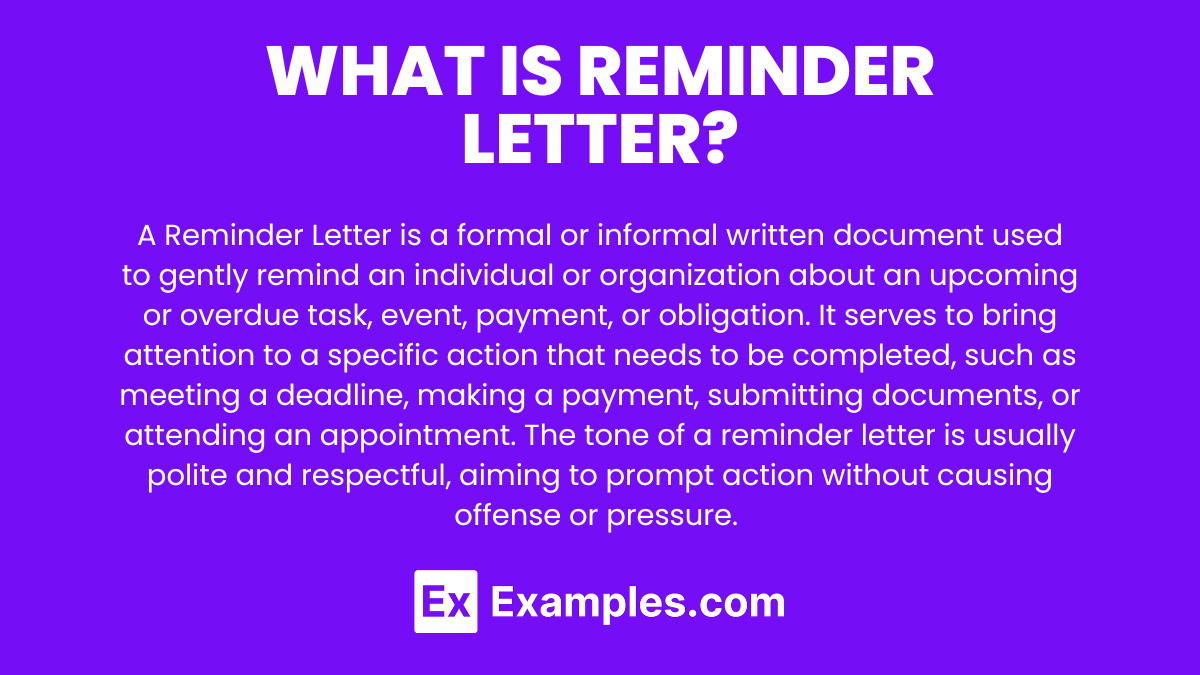
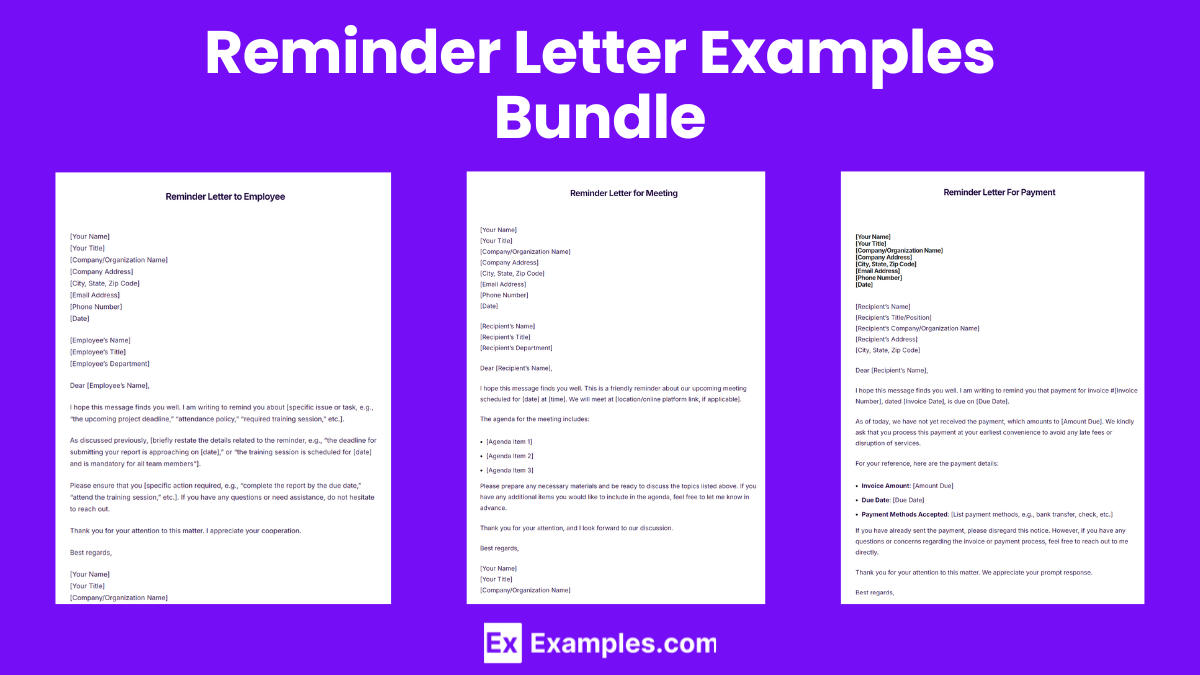
Download Reminder Letter Bundle
Reminder Letter Format
Opening Remarks
- Greeting: Begin with a polite and formal greeting.
- Examples:
- “Dear [Recipient’s Name],”
- “Hello [Recipient’s Name],”
Introduction
- Purpose: Briefly state the purpose of your reminder.
- Example:
- “I am writing to kindly remind you about the upcoming deadline for [mention task or obligation].”
Acknowledgments
- Reference to Previous Communication
- Reminder: Mention any previous correspondence regarding the task.
- Example:
- “As mentioned in our previous conversation/email dated [mention date], you were scheduled to [mention task].”
- Clarify the Importance
- Reason: Explain the significance of the action or task being reminded of.
- Example:
- “Completing this task on time is important for [mention reason, e.g., ‘keeping our project on schedule’].”
Details of Task or Obligation
- Specifics: Provide specific details about the task or obligation you are reminding the recipient of.
- Example:
- “We kindly ask you to submit [mention what is required] by [mention new deadline].”
Deadline or Action Required
- Urgency: Highlight any updated deadlines or required actions.
- Example:
- “To avoid delays, we would appreciate it if you could complete this by [mention exact date].”
Closing Remarks
- Summarize: Briefly recap the request.
- Example:
- “In conclusion, we kindly request that you complete [mention task] by the specified date.”
- Final Thanks: Offer a word of thanks for their attention and cooperation.
- Example:
- “Thank you for your prompt attention to this matter. We appreciate your cooperation.”
Farewell
- Goodbye: End with a polite closing.
- Example:
- “Sincerely,”
- “Best regards,”
Reminder Letter to Employee
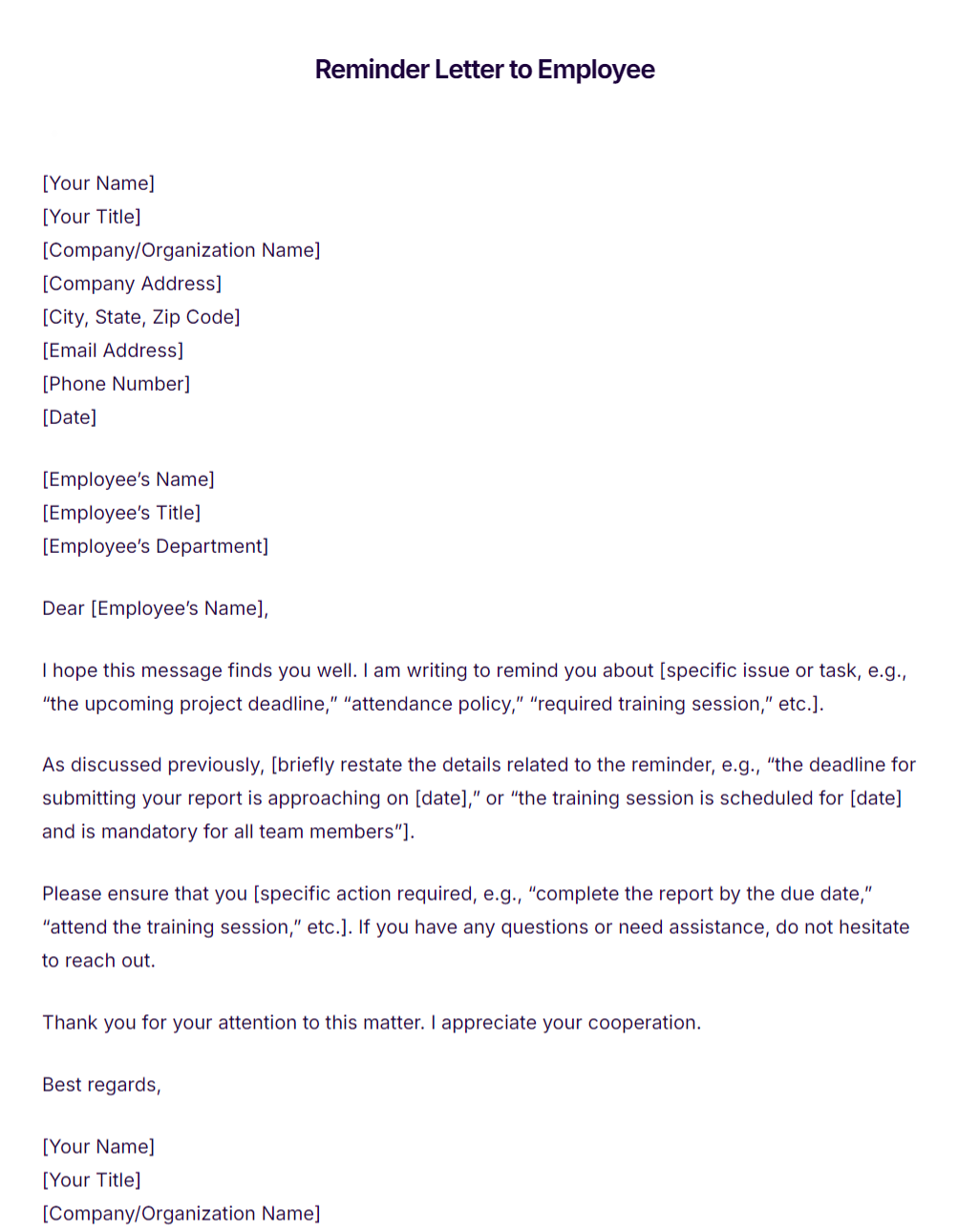
Reminder Letter for Meeting
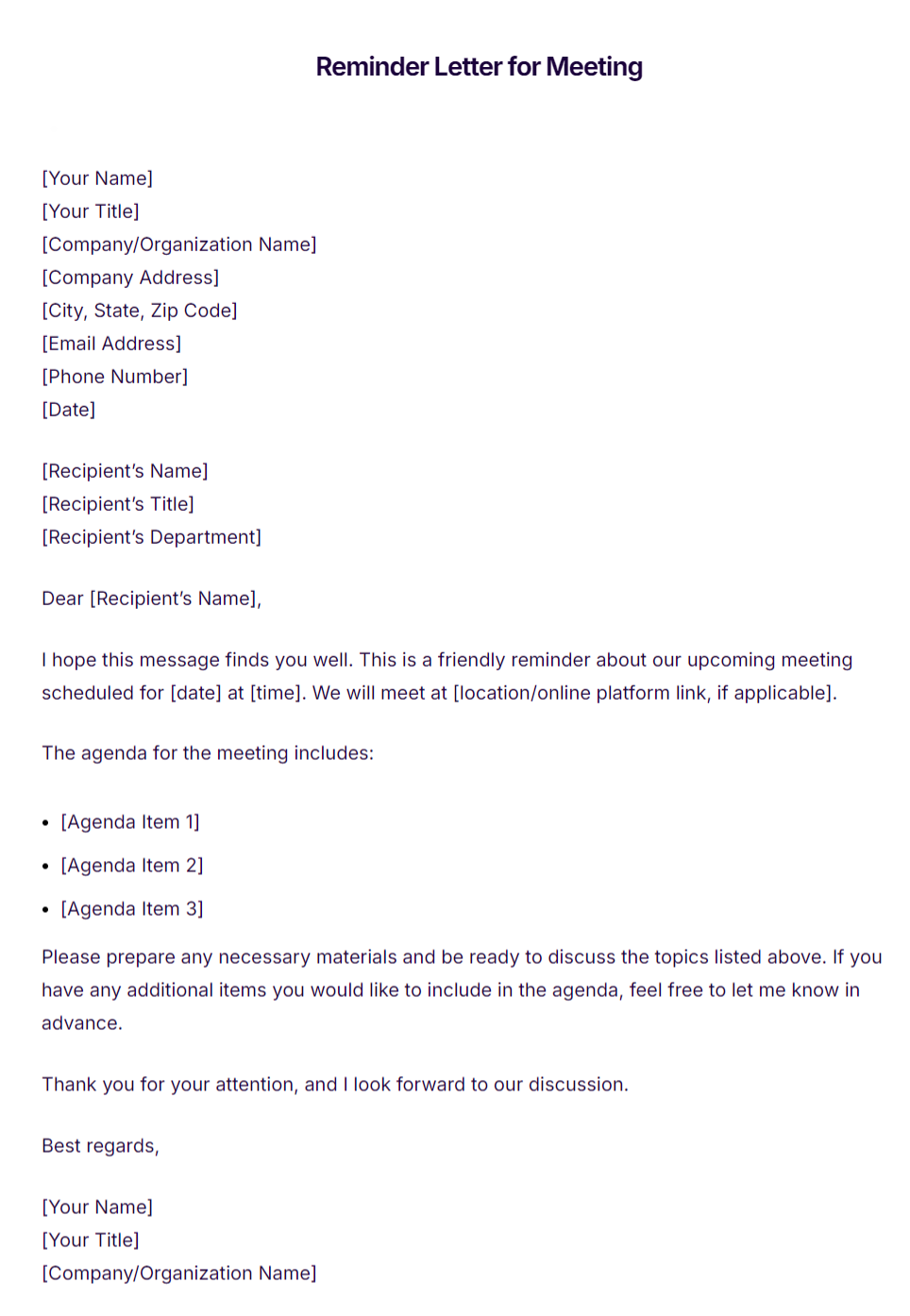
Reminder Letter for Payment
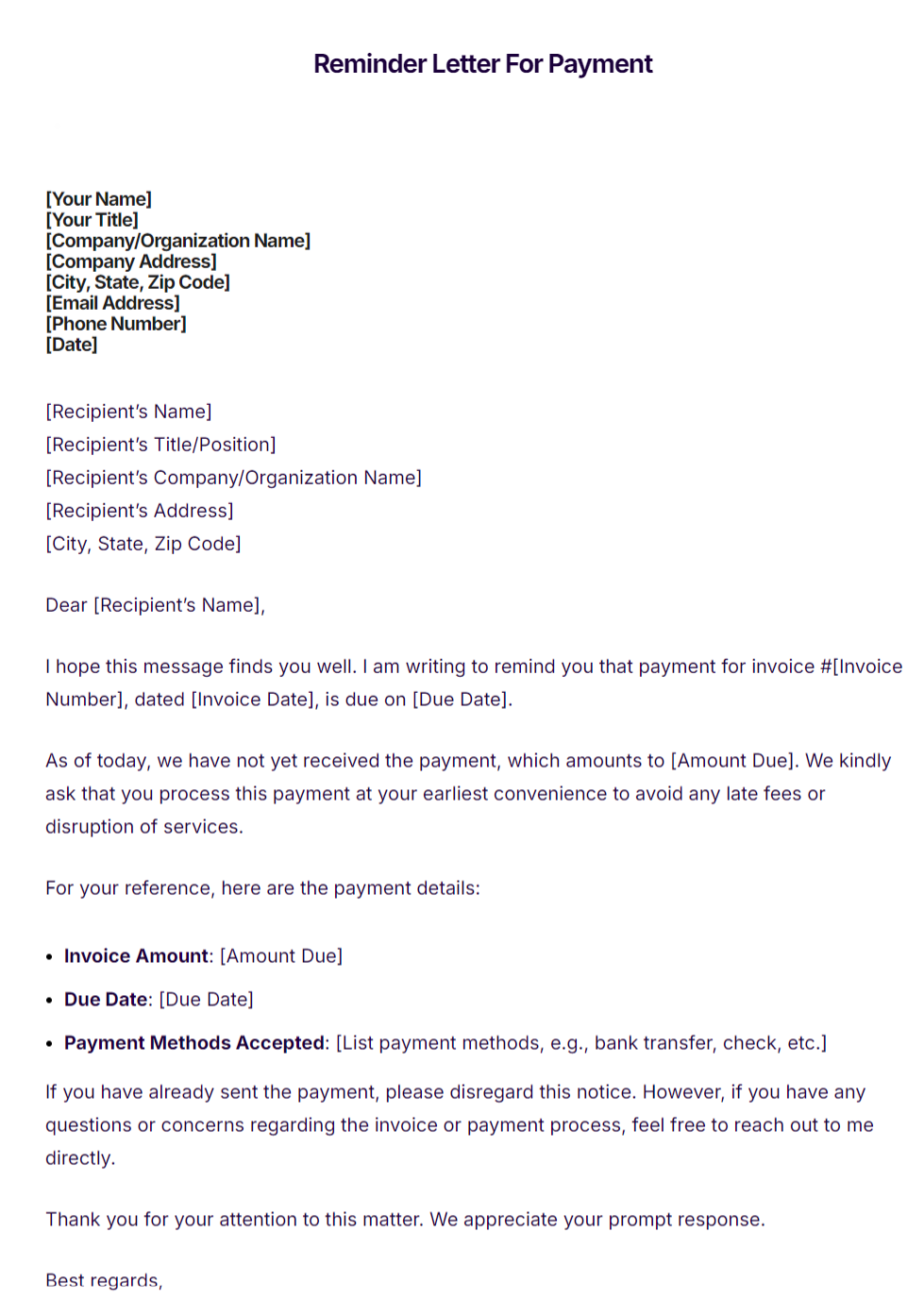
More Reminder Letter Examples and Samples
Letter of Reminder Example
[Your Name]
[Your Address]
[City, State, ZIP Code]
[Your Email Address]
[Your Phone Number]
[Date]
[Recipient’s Name]
[Recipient’s Address]
[City, State, ZIP Code]
Subject: Reminder for Outstanding Payment
Dear [Recipient’s Name],
I hope this letter finds you well. I am writing to remind you about an outstanding payment of $[Amount] that was due on [Due Date]. According to our records, this payment remains unpaid.
Invoice Number: [Invoice Number] Invoice Date: [Invoice Date] Amount Due: $[Amount]
We kindly request your prompt attention to this matter. It is essential that we receive this payment to ensure the continued smooth operation of our business and to maintain a positive financial standing. Please take a moment to review your records and process this payment as soon as possible.
You have several convenient payment options:
- Online Payment: Visit our website at [Website URL] and log in to your account to make a secure online payment.
- Bank Transfer: You can initiate a bank transfer to our account using the following details: Account Name: [Your Company Name] Account Number: [Account Number] Bank Name: [Bank Name] Routing Number (if applicable): [Routing Number]
- Check Payment: Please make the check payable to [Your Company Name] and mail it to the following address:
[Your Company Name] [Your Company Address] [City, State, ZIP Code]
If you have already processed the payment, please disregard this letter. However, if you have any questions or concerns regarding this payment or require an extension, please feel free to contact our accounts department at [Your Contact Information] or reply to this letter.
We appreciate your prompt attention to this matter and thank you for your continued partnership. We value your business and look forward to resolving this outstanding balance at your earliest convenience.
Sincerely,
[Your Name]
[Your Title]
[Your Company Name]
[Your Contact Information]
Reminder Letter Examples
1. Sample Reminder Letter Example
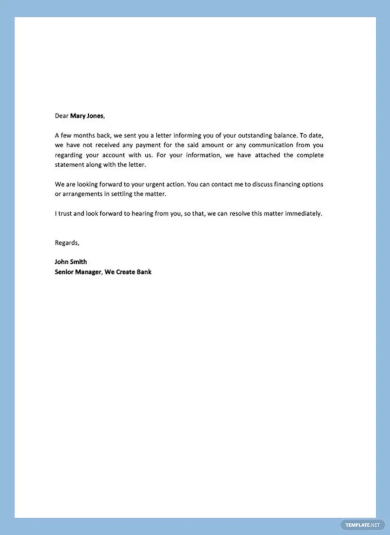
2. Late Payment Reminder Letter Example
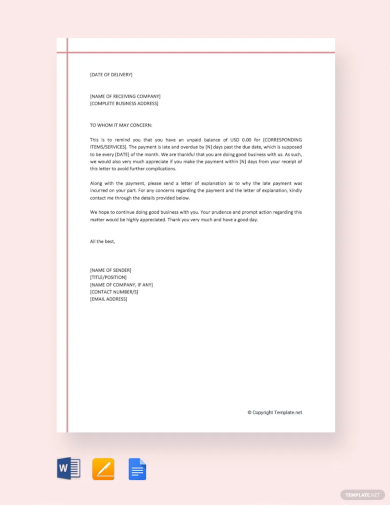
3. Outstanding Payment Reminder Letter Example
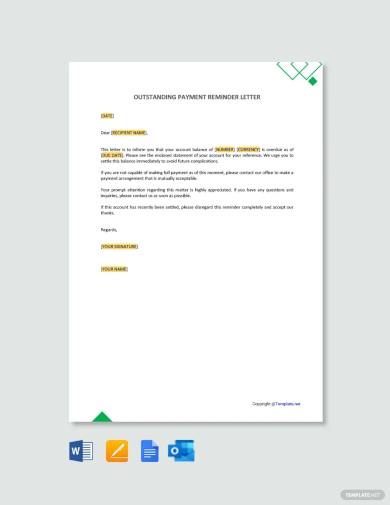
4. Free Sample Reminder Letter Example
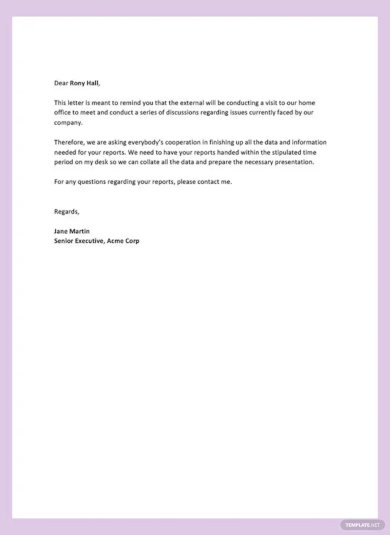
5. Overdue Payment Reminder Letter
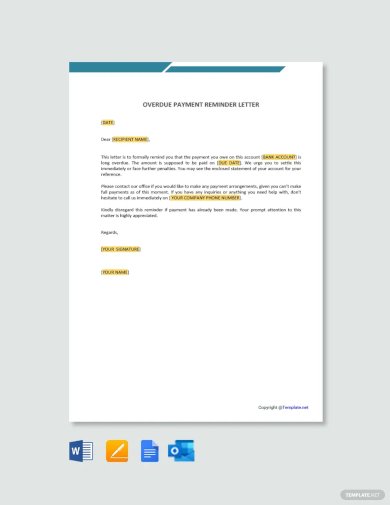
How to Write Reminder Letter?
Writing a Reminder Letter involves a clear, polite, and professional approach to ensure that the recipient is gently reminded of the task or obligation without causing offense. Here’s a step-by-step guide:
Use a Formal Tone
:Begin with a formal greeting and maintain a polite tone throughout. Avoid sounding accusatory or demanding.
Include Date and Recipient Information
:Start by including the date and the recipient’s name and contact details. This makes the letter clear and professional.
Reference the Original Request
:In the opening paragraph, briefly mention the original agreement or request that you are reminding them of. Be specific about what the letter is addressing, such as a missed deadline or upcoming payment.
State the Purpose Clearly
:Clearly explain the purpose of the letter, such as reminding about a due date, an unpaid invoice, or an upcoming meeting. Mention the date and the details of the missed or upcoming task.
Provide a New Deadline or Action Required
:If applicable, provide a new deadline or a timeframe for when the required action needs to be completed. This helps clarify the urgency of the situation.
Maintain Politeness and Professionalism
: TThroughout the letter, use respectful language and thank the recipient for their attention to the matter. Show understanding of any potential delays, if relevant.
End with a Polite Closing
:Conclude the letter by encouraging a prompt response or action. Use a closing phrase like “Sincerely” or “Thank you for your cooperation,” followed by your name and contact information.
FAQS
1. Can a Reminder Letter be sent by email?
Yes, a Reminder Letter can be sent by email if it suits the context. Ensure the email is formatted professionally, with a clear subject line, and follow the same guidelines for tone and content.
2. What is the purpose of a Reminder Letter?
The purpose of a Reminder Letter is to prompt action, remind the recipient of a responsibility, or bring attention to an upcoming event or missed obligation in a polite, formal manner.
3. What should I do if the recipient does not respond to the Reminder Letter?
If there is no response, you can send a follow-up letter or email, or escalate the matter depending on the urgency and importance. Remain polite but emphasize the importance of the action.
4. How long should a Reminder Letter be?
A Reminder Letter should be concise and straight to the point. One page is usually sufficient to cover all necessary information without overwhelming the recipient.
5. How do I maintain a polite tone in a Reminder Letter?
Use respectful language and avoid accusatory or harsh terms. Express understanding of potential delays or busy schedules, and offer to assist if necessary. Keep the message professional and considerate.


